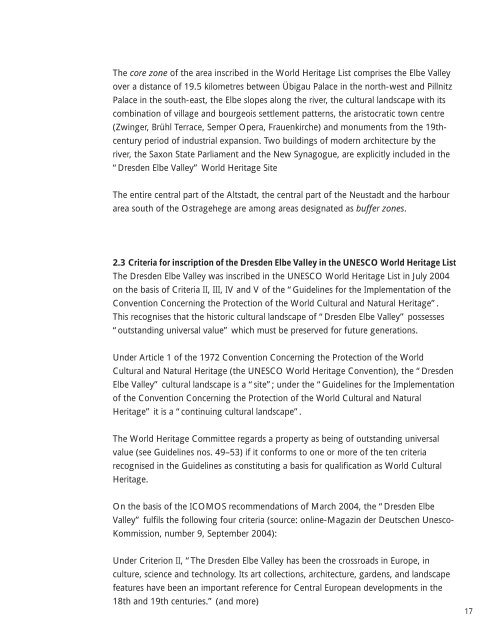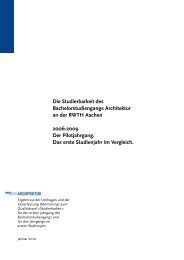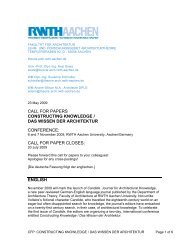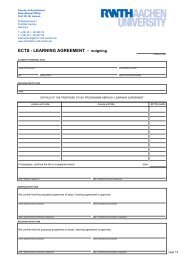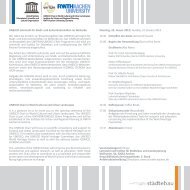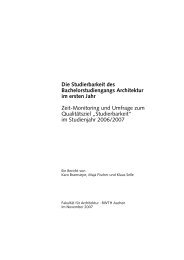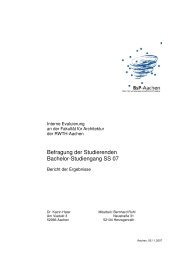Gutachten Dresden_englisch_dritte f.indd - Fakultät für Architektur ...
Gutachten Dresden_englisch_dritte f.indd - Fakultät für Architektur ...
Gutachten Dresden_englisch_dritte f.indd - Fakultät für Architektur ...
Create successful ePaper yourself
Turn your PDF publications into a flip-book with our unique Google optimized e-Paper software.
The core zone of the area inscribed in the World Heritage List comprises the Elbe Valley<br />
over a distance of 19.5 kilometres between Übigau Palace in the north-west and Pillnitz<br />
Palace in the south-east, the Elbe slopes along the river, the cultural landscape with its<br />
combination of village and bourgeois settlement patterns, the aristocratic town centre<br />
(Zwinger, Brühl Terrace, Semper Opera, Frauenkirche) and monuments from the 19th-<br />
century period of industrial expansion. Two buildings of modern architecture by the<br />
river, the Saxon State Parliament and the New Synagogue, are explicitly included in the<br />
“<strong>Dresden</strong> Elbe Valley” World Heritage Site<br />
The entire central part of the Altstadt, the central part of the Neustadt and the harbour<br />
area south of the Ostragehege are among areas designated as buffer zones.<br />
2.3 Criteria for inscription of the <strong>Dresden</strong> Elbe Valley in the UNESCO World Heritage List<br />
The <strong>Dresden</strong> Elbe Valley was inscribed in the UNESCO World Heritage List in July 2004<br />
on the basis of Criteria II, III, IV and V of the “Guidelines for the Implementation of the<br />
Convention Concerning the Protection of the World Cultural and Natural Heritage”.<br />
This recognises that the historic cultural landscape of “<strong>Dresden</strong> Elbe Valley” possesses<br />
“outstanding universal value” which must be preserved for future generations.<br />
Under Article 1 of the 1972 Convention Concerning the Protection of the World<br />
Cultural and Natural Heritage (the UNESCO World Heritage Convention), the “<strong>Dresden</strong><br />
Elbe Valley” cultural landscape is a “site”; under the “Guidelines for the Implementation<br />
of the Convention Concerning the Protection of the World Cultural and Natural<br />
Heritage” it is a “continuing cultural landscape”.<br />
The World Heritage Committee regards a property as being of outstanding universal<br />
value (see Guidelines nos. 49–53) if it conforms to one or more of the ten criteria<br />
recognised in the Guidelines as constituting a basis for qualification as World Cultural<br />
Heritage.<br />
On the basis of the ICOMOS recommendations of March 2004, the “<strong>Dresden</strong> Elbe<br />
Valley” fulfils the following four criteria (source: online-Magazin der Deutschen Unesco-<br />
Kommission, number 9, September 2004):<br />
Under Criterion II, “The <strong>Dresden</strong> Elbe Valley has been the crossroads in Europe, in<br />
culture, science and technology. Its art collections, architecture, gardens, and landscape<br />
features have been an important reference for Central European developments in the<br />
18th and 19th centuries.” (and more)<br />
17


